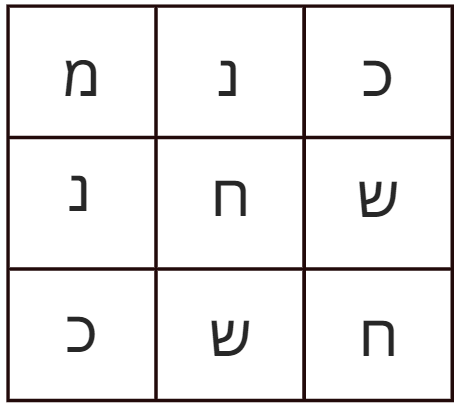While reciting the Haggadah, right after we list the 10 plagues, we say, “Rabbi Yehuda used to give the ten plagues a siman (a mnemonic): דצ"ך עד"ש באח"ב, Detzach Adash Be-achav,” with each plague being represented by a letter. What is the purpose of this mnemonic, and why is it in the Seder?
He Often Gave Mnemonics
There are several places in the Talmud where Rabbi Yehuda offers mnemonic devices to help remember certain passages or lists. This was especially important at a time when most learning had to be committed to memory. Based on this, some explain that this is just another example of Rabbi Yehuda’s helpful mnemonic devices.1
Correct Order of Plagues
Some explain2 that Rabbi Yehuda is pointing out that the order in which the plagues occurred is, in fact, the same order stated in Exodus. This needs to be clarified because Psalms lists some of the plagues in a different order:
Psalm 78:43-51: Blood, Wild Animals, Frogs, Locusts, Hail, Plague, Firstborn
Psalm 105:27-36: Darkness, Blood, Frogs, Wild Animals, Lice, Hail, Locusts, Firstborn
Thus, Rabbi Yehuda’s mnemonic reminds us of the correct order in which the plagues occurred.3
Engraved on Moses' staff
According to Rabbi Yehuda himself, this acronym is significant; it was inscribed on Moses’ staff (through which some of the plagues were brought about).4 To call attention to this, we recite the mnemonic here.5
What is the deeper meaning behind this mnemonic, to the point that it was etched into Moses' staff?
Three Groups of Plagues
Many commentaries note that this mnemonic groups the plagues into three:
- Blood, Frogs, Lice
- Wild Animals, Cattle Disease, Boils
- Hail, Locusts, Darkness, Firstborn.
They offer a number of explanations regarding the significance of this grouping. Here are just a few:
- The Catalyst
The first group of plagues (Blood, Frogs, Lice) came about through Aaron and his staff. The second group of plagues (Wild Animals, Cattle Disease, Boils) came about through Moses, but without the staff. The third group (Hail, Locusts, Darkness, Firstborn) came about through Moses and his staff.6
- The Warning
The first two plagues, Blood and Frogs, were preceded by a warning, but Lice was not.7 This pattern repeated itself three times, as reflected in the three-part mnemonic.8 Although the plague of the Firstborn was forewarned, it had no plagues that followed it, so it was tacked onto the end of the last group.9
- The Lesson
Each group of plagues came to teach the Egyptians another lesson. This is illustrated by the verses that precede each of these groups:10
G‑d’s existence. The first group of plagues is introduced with the verse: “So said the L‑rd, ‘With this you will know that I am the L‑rd . . ."11
Divine Providence: The second group of plagues is introduced with the verse: “. . . In order that you know that I am the L‑rd in the midst of the earth.”12
G‑d is omnipotent: The final group of plagues is preceded by the verse: “. . . In order that you know that there is none like Me in the entire earth.”13
- Three plagues that happened in conjunction
Rabbi Yehuda divided the plagues this way to stress that the third plague in each group—Lice, Boils and Darkness—worked together with the others. So, for example, during the plague of lice, there were also boils and darkness, but lice were the main affliction. The interrelatedness of these plagues can be seen when one writes out the names of the plagues in a grid. The three words can be read both from right to left as well as from bottom to top:14

Working Up the Natural Order
As mentioned above, the plagues follow a pattern, split into units of three.
The groups work their way up through the elements of creation, targeting different parts of existence, refining and elevating them one at a time. The first group is in the earth itself—water turns to blood, frogs emerge from the water, and dust is turned into lice. The second group is on the land—plagues against man and animals. The third group is in the sky—hail comes from the sky, locusts block out the heavenly bodies, and darkness completely blocks out the light of the sun.
Within each group, the intensity increases as well. The first plague of each group is preceded by a warning to Pharaoh issued by the Nile (outside of Pharaoh's seat of power). The second of each group is preceded by a warning issued to Pharaoh while he is sitting on his throne (which is closer to home). The third of each group has no warning at all.
The final plague is a "grand finale," the culmination of the entire display.15
The Numerical Value of All 500 Plagues
The numerical value of דצ”ך עד”ש באח”ב is 501.
Right after we list the ten plagues, the Haggadah notes that Rabbi Yossi Haglili says that the 10 plagues really consisted of 50 plagues, Rabbi Eliezer says 200, and Rabbi Akiva says 250. Altogether, they equal 500. Thus, Rabbi Yehuda is hinting that all of the different opinions are correct, and there were 500 sub-plagues contained within the ten plagues.16 The extra “1”17 either refers to the “finger of G‑d”18 or the unified totality of all the details.19
The Sickness of Egypt
The numerical value of the word אשר, asher, is also 501.
When Moses came to warn Pharaoh to release the Jewish people, Pharoah replied, "Who is the L‑rd that [asher] I should heed His voice to let Israel out?”20
Thus, Rabbi Yehuda is pointing out that Pharaoh's own words hint that he will eventually let the Jews out after asher, the Ten Plagues.
Furthermore, when G‑d tells the Jewish people that if they heed His commandments, “all the sicknesses that [asher] I have visited upon Egypt I will not visit upon you, for I, the L‑rd, heal you,”21 the word asher is also a hint to the plagues that G‑d will not visit upon the Jewish people.22







Join the Discussion